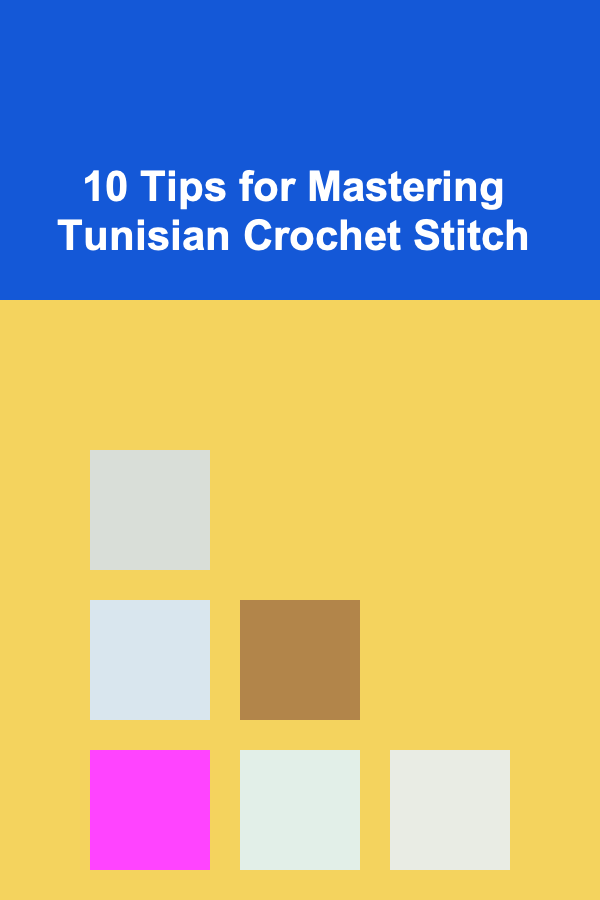
10 Tips for Mastering Tunisian Crochet Stitch
ebook include PDF & Audio bundle (Micro Guide)
$12.99$11.99
Limited Time Offer! Order within the next:

Tunisian crochet, also known as Afghan crochet, is a unique and fascinating technique that blends elements of both knitting and traditional crochet. With its characteristic dense, woven texture and its ability to create a wide variety of patterns, Tunisian crochet can add depth and intricacy to any crochet project. Whether you're a seasoned crocheter or just starting out, mastering Tunisian crochet stitches can significantly expand your creative possibilities.
In this article, we will explore 10 essential tips to help you master the Tunisian crochet stitch, improve your technique, and achieve beautiful results in your projects. These tips are designed to build your understanding of Tunisian crochet while providing practical advice for both beginners and experienced crocheters.
Understand the Basics of Tunisian Crochet
Before diving into advanced techniques, it's essential to first understand the basics of Tunisian crochet. This technique is different from traditional crochet because it requires a specialized Tunisian crochet hook, which is longer than a standard crochet hook and sometimes has a stopper at the end.
The process involves two main phases:
- Foundation Row: This is where you create the initial foundation of loops across the row.
- Return Pass: The return pass is where you complete the row by pulling the yarn through all the loops on the hook.
In Tunisian crochet, you work on one side of the fabric at a time, unlike traditional crochet, where you alternate between working through the front and back loops.
Mastering these two phases will set you up for success in all your Tunisian crochet projects.
Choose the Right Hook and Yarn
Selecting the right hook and yarn for Tunisian crochet can significantly impact your success with the stitch. The unique nature of Tunisian crochet means that your yarn and hook need to complement each other to ensure that the fabric flows smoothly and the stitch formation is even.
Choosing the Hook
Tunisian crochet hooks come in different lengths and materials, such as bamboo, plastic, and aluminum. If you are just beginning, here are some tips to keep in mind:
- Length: The hook should be long enough to hold all the loops from the foundation row. Depending on your project, you may need a longer hook, especially for larger projects.
- Material: Bamboo hooks are often a great choice because they provide a bit of friction, helping to prevent stitches from sliding off. Aluminum or plastic hooks are smoother and can allow for faster stitching.
- Ergonomics: Since Tunisian crochet involves holding a lot of loops at once, an ergonomic hook can help reduce hand strain.
Choosing the Yarn
While you can use almost any yarn for Tunisian crochet, it's essential to choose one that's not too thick or thin. Opt for medium-weight yarn (such as worsted weight) for easier stitch manipulation. Additionally:
- Yarn with good stitch definition: Yarn that provides good stitch definition (like wool or acrylic) will make your stitches stand out clearly.
- Color: Light-colored yarn can help you see the stitches better as you're learning, but darker colors can be better for textured patterns once you gain experience.
Perfect Your Tension Control
One of the most common challenges when learning Tunisian crochet is managing tension. Since you're holding so many loops on the hook at once, it's easy for the tension to become too tight or too loose, affecting the overall look and feel of your project.
Here are some tips for perfecting your tension:
- Practice with tension: Before beginning a major project, practice the Tunisian stitch with a few swatches to experiment with your tension.
- Consistent loop size: Make sure the loops on your hook are of a consistent size. If they're too tight, it will be difficult to complete the return pass; if they're too loose, the fabric may look uneven.
- Adjust as you go: Keep an eye on your tension throughout the project. If the fabric feels too tight or too loose, adjust your grip or yarn usage.
Tension control is crucial to achieving even and uniform stitches throughout your work.
Master the Return Pass
The return pass in Tunisian crochet is often what challenges beginners. It's essential to understand how to complete this phase smoothly and consistently.
Here's how to improve your return pass technique:
- Relax your grip: When completing the return pass, try not to hold the yarn too tightly. A relaxed grip will allow the yarn to glide more easily through the loops, making the process faster and smoother.
- Pull evenly: When you pull the yarn through the loops on your hook, make sure to do so evenly to avoid creating uneven edges.
- Practice with smaller projects: Before tackling large blankets or garments, practice your return pass on smaller swatches to improve your speed and consistency.
Mastering the return pass is key to making your Tunisian crochet projects look polished and professional.
Learn the Basic Tunisian Stitches
Once you're comfortable with the foundation row and return pass, it's time to learn the basic Tunisian crochet stitches. These are the building blocks of many Tunisian crochet patterns and will give you a solid foundation for more complex projects.
Here are some of the fundamental stitches you should practice:
- Tunisian Simple Stitch (TSS): This is the most basic stitch in Tunisian crochet. It creates a dense, fabric-like texture and is used in many patterns.
- Tunisian Knit Stitch (TKS): This stitch mimics the appearance of knitting, providing a smooth, stretchy texture.
- Tunisian Purl Stitch (TPS): Similar to the TKS, but it creates a purl-like texture, often used in combination with the knit stitch.
- Tunisian Extended Stitch (TES): This stitch is a variation of the simple stitch and provides a more open texture.
Once you've mastered these basic stitches, you'll be able to create an array of patterns, including textured stitches and colorwork designs.
Work in the Round
While traditional crochet is usually worked in rows, Tunisian crochet can also be done in the round. Working in the round requires a few extra steps, but it can open up a whole new set of possibilities for Tunisian crochet projects, including hats, bags, and seamless garments.
To work in the round:
- Join with a slip stitch: At the end of your foundation row, join your work in the round with a slip stitch to the first stitch.
- Work on the front loops: When working in the round, you'll need to work into the front loops of each stitch to maintain the round shape.
With a little practice, Tunisian crochet in the round can help you create a wide range of exciting projects, such as hats, scarves, and baskets.
Experiment with Textured Stitches
One of the most exciting aspects of Tunisian crochet is its ability to create beautifully textured fabrics. By combining different stitches and playing with variations, you can create stunning, intricate textures that add dimension to your projects.
Here are a few textured stitches to try:
- Tunisian Honeycomb: This stitch creates a raised, hexagonal pattern that looks like honeycomb.
- Tunisian Shell Stitch: The shell stitch creates a ruffled, shell-like pattern and works great for adding visual interest.
- Tunisian Cable Stitch: This stitch mimics the look of cables in knitting, providing a sophisticated, woven effect.
To experiment with textured stitches, try working a swatch with a combination of these techniques. The beauty of Tunisian crochet is that you can easily modify the texture by switching between stitches.
Use Tunisian Crochet for Colorwork
Tunisian crochet is a fantastic technique for incorporating colorwork into your designs. Whether you want to add stripes, color blocks, or more intricate patterns, colorwork can significantly enhance the visual appeal of your project.
Here's how to incorporate colorwork:
- Stripes: Change yarn colors after completing the foundation row, and continue alternating colors to create stripes.
- Mosaic Patterns: Use two or more colors to create a mosaic-like effect by working with a color in certain stitches and switching colors in others.
- Tunisian Colorwork Stitches: Learn specific Tunisian crochet colorwork stitches such as the Tunisian entrelac, which creates a patchwork effect.
Tunisian crochet's ability to easily combine multiple colors makes it perfect for projects like blankets, scarves, and bags.
Incorporate Tunisian Crochet into Projects
Now that you've mastered the fundamentals of Tunisian crochet, it's time to incorporate this stitch into various projects. From home décor to fashion accessories, there are endless opportunities for using Tunisian crochet to enhance your creations.
Some popular project ideas for Tunisian crochet include:
- Blankets: Tunisian crochet is perfect for creating cozy, textured blankets with its thick, warm fabric.
- Shawls: The open, airy texture of Tunisian crochet makes it ideal for lightweight shawls and wraps.
- Hats and Scarves: By incorporating textured stitches, you can create stylish and functional hats and scarves.
- Bags: Tunisian crochet is perfect for making sturdy, structured bags that hold their shape.
Don't Be Afraid to Experiment
Tunisian crochet is a versatile and creative technique, so don't be afraid to experiment. Whether it's trying out new stitches, incorporating color, or adapting patterns to suit your unique style, there's no limit to what you can create with this stitch.
As you become more comfortable with Tunisian crochet, allow yourself to push boundaries and challenge your skills. This will not only help you improve your technique but also encourage you to discover new, exciting ways to use the stitch.
Conclusion
Mastering Tunisian crochet takes time and practice, but with these 10 tips, you'll be well on your way to creating beautiful, textured pieces. Whether you're making a cozy blanket or an intricate shawl, Tunisian crochet provides endless opportunities for creativity. Keep experimenting, learning new stitches, and perfecting your technique, and soon you'll be creating stunning projects that showcase the beauty and versatility of this unique crochet technique.
Reading More From Our Other Websites
- [Home Pet Care 101] How to Maintain Your Pet's Health During Seasonal Changes
- [Organization Tip 101] How to Use Drawer Dividers for High-End Cosmetics
- [Home Space Saving 101] How to Maximize Bedroom Space with Space-Saving Furniture Ideas
- [Home Holiday Decoration 101] How to Make Your Home Smell Like the Holidays Using Natural Scents
- [Home Pet Care 101] How to Choose Pet-Friendly Furniture for Your Home
- [Home Pet Care 101] How to Set Up a Pet-Friendly Bedroom for Better Sleep
- [Personal Financial Planning 101] Best Tools and Resources for Effective Personal Financial Planning
- [Organization Tip 101] How to Set Up a Budgeting Station at Home
- [Organization Tip 101] How to Reupholster Mid-Century Modern Chairs for a Contemporary Twist
- [Personal Care Tips 101] How to Stay Fresh and Confident with Deodorizing Foot Spray in Summer

How to Create a Checklist for Post-Event Promotion and Follow-up
Read More
How to Maintain Your Home's Water Heater for Optimal Performance
Read More
How to Pack for a Backpacking Adventure: A Minimalist Packing Checklist
Read More
How to Prepare for Major Life Changes: Financial Tips for Transitions
Read More
Identifying Birds by Color Patterns: A Comprehensive Guide
Read More
10 Tips for Packing Eco-Friendly Travel Essentials
Read MoreOther Products

How to Create a Checklist for Post-Event Promotion and Follow-up
Read More
How to Maintain Your Home's Water Heater for Optimal Performance
Read More
How to Pack for a Backpacking Adventure: A Minimalist Packing Checklist
Read More
How to Prepare for Major Life Changes: Financial Tips for Transitions
Read More
Identifying Birds by Color Patterns: A Comprehensive Guide
Read More